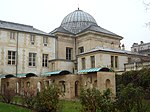The Basilica of Saint-Denis (French: Basilique royale de Saint-Denis, now formally known as the Basilique-cathédrale de Saint-Denis) is a large former medieval abbey church and present cathedral in the commune of Saint-Denis, a northern suburb of Paris. The building is of singular importance historically and architecturally as its choir, completed in 1144, is widely considered the first structure to employ all of the elements of Gothic architecture.The basilica became a place of pilgrimage and a necropolis containing the tombs of the Kings of France, including nearly every king from the 10th century to Louis XVIII in the 19th century. Henry IV of France came to Saint-Denis to formally renounce his Protestant faith and become a Catholic. The Queens of France were crowned at Saint-Denis, and the royal regalia, including the sword used for crowning the kings and the royal sceptre, were kept at Saint-Denis between coronations.The site originated as a Gallo-Roman cemetery in late Roman times. The archaeological remains still lie beneath the cathedral; the graves indicate a mixture of Christian and pre-Christian burial practices. Around the year 475 AD, St. Genevieve purchased some land and built Saint-Denys de la Chapelle. In 636, on the orders of Dagobert I, the relics of Saint Denis, a patron saint of France, were reinterred in the basilica. The relics of St-Denis, which had been transferred to the parish church of the town in 1795, were brought back again to the abbey in 1819.In the 12th century, the Abbot Suger rebuilt portions of the abbey church using innovative structural and decorative features. In doing so, he is said to have created the first truly Gothic building. In the following century the master-builder Pierre de Montreuil rebuilt the nave and the transepts in the new Rayonnant Gothic style.The abbey church became a cathedral on the formation of the Diocese of Saint-Denis by Pope Paul VI in 1966 and is the seat of the Bishop of Saint-Denis, currently (since 2009) Pascal Delannoy. Although known as the "Basilica of St Denis", the cathedral has not been granted the title of Minor Basilica by the Vatican.The 86-metre (282-foot) tall spire, dismantled in the 19th century, is to be rebuilt. The project, initiated more than 30 years ago, was to have begun in May 2020, and is expected to take about 11 years at a cost of about €28 million.










